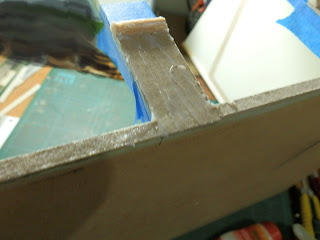Today we're talking about the floor...
Encontrei pouquíssimas fotos de interior de lojas daquela época. Então, nesta parte toda vou usar uma mistura de bom-senso (baseado nas fotos e pesquisas que fiz) e "liberdade criativa", ou 'imaginação' pura e simples, hehe...
Visual reference of stores interiors from that time were awfully scarce. So, for the inside of the store I'll use a mixture of common sense (an educated guess based on all the research I made) and 'creative freedom', or pure and simple 'imagination', lol...
 |
| Interior de uma loja de tecidos no final do século 19. Inside a store, turn of the 19th century. |
All buildings from the 19th century that I have been to had one of the two kinds of flooring: wood planks (the long and dark kind) or marble. Even though my store must have a certain degree of sophistication, due to its French influence - the reference for elegance back then - it's not exactly the elite kind. To be that, it would have to have more than one floor, and even maybe elevators! So, wood planks it is, and I kind of like it better too.
A estrutura, depois de 3 anos 'largada', estava cheia de pó e suja. Refiz a pintura toda por dentro e cortei uma placa de papelão paraná seguindo o contorno interno.
The store structure, after 3 years 'abandoned' on a shelf, was covered in dust and really dirty. I cleaned and repainted it inside. Then I cut a piece of solid cardboard following the measures of the floor inside.
 |
| eca! eeww! |
 |
| limpinho é melhor... :) fresh and clean is better... :) |
I painted this cardboard with dark brown so that if the 'planks' didn't fit perfectly (they rarely do, lol), that wouldn't show too much. And I cut several strips of a dark veneer wood my 'old' teacher, Angelo Pinheiro had bought for me at a specialized store in Sao Paulo, way back then (2009). Each strip was about 3/8" x 6", quite reasonable, I believe.
Comecei pelas beiradas, fazendo o contorno todo. Os cantos foram esquadrejados (cortados em ângulo de 45º), como em molduras. Aí fazer o 'miolo' foi fácil. Foi mais um trabalho de paciência do que de habilidade... Alternei as distâncias cortando algumas tiras de madeira pela metade, como seria a disposição normal.
I started working the edges, making a kind of mitered frame for the floor. The 'core' was much easier. It was more a work of patience than skill... I alternated the lengths by cutting some strips/planks in half lengthwise.
Depois lixei bem, até ficar bem lisinho. Queria um brilho suave, pois na época não existia sinteco!!! Comecei usando cera de abelha. Esfreguei bem e depois lixei. Dá trabalho e gastei várias tiras de lixa, pois o excesso de cera que sai vai ficando todo na lixa... Ficou legal, mas eu queria um pouco mais de brilho (não muito).
After finished and dry, I sanded over and over until it was very smooth. I wanted my floor to have a very soft shine to it, but not too much, as back then Synteko hadn't been invented yet!!! I started by rubbing bee's wax. Then sanded again. There's a lot of work and effort to it, as the excess wax sticks to the sandpaper and I had to keep changing it again and again... I liked the result, but I wanted a little bit more shine to it.
 |
| esse 'treco' é a cera de abelha This 'thing' is bee's wax |
 |
| o lado esquerdo não tem nada, para comparar. the left side has no wax, just for comparison reasons. |
 |
| a lixa e o piso lixado (só no lado direito) the sandpaper after use and, again, only right side has been worked on. |
 |
| todo o piso já 'encerado' e lixado. All done! |
Aí lembrei que na época já existia acabamento com Goma Laca. É um produto natural e diluido em álcool e que dá muito brilho. Passei uma camada de laca incolor, deixei secar bem e passei bom-bril. Sim, isso mesmo! Bom-bril!!! Dá brilho, rsrs... Gostei do resultado, e você? :)
Then I remembered that back then they already used Shellac. It's a natural alcohol based product. I applied one single coat of a more modern colorless version of it and, when dry, worked on it with steel wool. That's correct, the kind we use in the kitchen! It's great for shellac, lol... I liked the way it turned out, and you? :) |
| O rodapé mais estreito faz a loja parece maior, não? :) The narrow footer (actually a chair railing) makes the store look bigger, doesn't it? :) |
 |
| Obrigada! Thank you! |









































